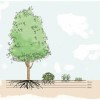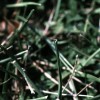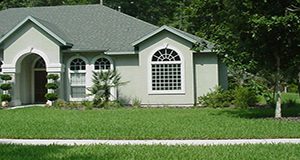Excess nitrogen (N) and phosphorus (P) in water bodies are a leading cause of water quality degradation statewide. More than 50 Florida counties and municipalities now have formal fertilizer ordinances, which in some cases include fertilizer blackouts, or bans on the usage of N and P fertilizers during certain times of the year. This 8-page document provides information on the underlying issues of fertilizer use, with an emphasis on an urban setting, and outlines the current state of the science on urban fertilizers and water quality in Florida. Written by Michael D. Dukes, Lisa Krimsky, Mary Lusk, Laurie Trenholm, Bryan Unruh, Michelle Atkinson, and Rao Mylavarapu, and published by the UF/IFAS Department of Agricultural and Biological Engineering, February 2020.
https://edis.ifas.ufl.edu/ae534
Tag: Laurie Trenholm
La Grama St. Augustine para Patios de Florida
La grama o césped St. Augustine está muy adaptada a las zonas calurosas y húmedas (subtropicales) del mundo. Se cree que es nativa de las regiones costeras del Golfo de México y del Mediterráneo. St. Augustine es la especie de grama más usada en Florida. This is the Spanish-language version of ENH5/LH010, St. Augustinegrass for Florida Lawns. St. Augustinegrass is the most commonly-used lawn grass in Florida. This 10-page document describes its cultivation and management for Florida lawns. Written by L. E. Trenholm, J. B. Unruh, T. W. Shaddox, C. Balerdi, and H. Mayer and published by the UF/IFAS Department of Environmental Horticulture, January 2018.
http://edis.ifas.ufl.edu/ep552
How to Calibrate Your Fertilizer Spreader
Fertilizer application is only effective if you ensure uniform coverage. This 5-page document discusses the calibration and use of fertilizer spreaders for successful application. Written by T.W. Shaddox, J.B. Unruh, and L.E. Trenholm and published by the UF/IFAS Environmental Horticulture Department, November 2017.
http://edis.ifas.ufl.edu/lh024
Environmental Stresses and Your Florida Lawn

Florida lawns are subject to many environmental stresses. These can include nutrient deficiency, salinity, temperature extremes, over- or under-watering, soil problems, and prolonged exposure to shade or traffic. The use of proper cultural practices will help keep your lawn healthy and more stress-tolerant. This two-page fact sheet explains how to choose the most appropriate grass, fertilize properly, mow to the correct height, and irrigate for your lawn’s needs. Written by L.E. Trenholm, and published by the Environmental Horticulture Department.
http://edis.ifas.ufl.edu/ep070
Homeowner Best Management Practices for the Home Lawn
 A healthy lawn is an important component of an urban landscape. Loss of turf health and misuse of fertilizers can result increased nonpoint source pollution, so homeowners should use Best Management Practices when maintaining their lawns. Best Management Practices follow Florida-Friendly Landscaping™ principles, developed for maintenance of a healthy landscape that does not contribute to nonpoint source pollution. This 6-page fact sheet provides easy-to-follow tips on Florida-friendly lawn maintenance. Written by Laurie E. Trenholm, and published by the UF Department of Environmental Horticulture, October 2014.
A healthy lawn is an important component of an urban landscape. Loss of turf health and misuse of fertilizers can result increased nonpoint source pollution, so homeowners should use Best Management Practices when maintaining their lawns. Best Management Practices follow Florida-Friendly Landscaping™ principles, developed for maintenance of a healthy landscape that does not contribute to nonpoint source pollution. This 6-page fact sheet provides easy-to-follow tips on Florida-friendly lawn maintenance. Written by Laurie E. Trenholm, and published by the UF Department of Environmental Horticulture, October 2014.
http://edis.ifas.ufl.edu/ep236
The Role of Soil Management in Minimizing Water and Nutrient Losses from the Urban Landscape
 Soil is the most important building block of a healthy, attractive landscape, serving many important physical, chemical, and biological functions. Soil provides a physical substrate for plant support and holds nutrients and water for plant use. It also facilitates groundwater recharge (water moving from surface water to groundwater) and provides long-term storage for organic matter. Soil also provides a habitat for microorganisms that aid in the transformation and availability of nutrients. Soil is an integral part of any ecosystem, but urbanization often changes soils in ways that negatively affect plant development. Soils in urban areas may have reduced water infiltration, resulting in increased runoff and increased potential for nutrient losses. Homeowners in urban areas often overcompensate for poor planting conditions by applying inappropriate amounts of fertilizer and water. These practices eventually lead to nutrient losses through stormwater runoff or soil leaching, and these lost nutrients negatively impact groundwater and ecosystems in nearby springs, streams, and water bodies. This 6-page fact sheet was written by George Hochmuth, Laurie Trenholm, Esen Momol, Don Rainey, Claire Lewis, and Brian Niemann, and published by the UF Department of Soil and Water Science, November 2013.
Soil is the most important building block of a healthy, attractive landscape, serving many important physical, chemical, and biological functions. Soil provides a physical substrate for plant support and holds nutrients and water for plant use. It also facilitates groundwater recharge (water moving from surface water to groundwater) and provides long-term storage for organic matter. Soil also provides a habitat for microorganisms that aid in the transformation and availability of nutrients. Soil is an integral part of any ecosystem, but urbanization often changes soils in ways that negatively affect plant development. Soils in urban areas may have reduced water infiltration, resulting in increased runoff and increased potential for nutrient losses. Homeowners in urban areas often overcompensate for poor planting conditions by applying inappropriate amounts of fertilizer and water. These practices eventually lead to nutrient losses through stormwater runoff or soil leaching, and these lost nutrients negatively impact groundwater and ecosystems in nearby springs, streams, and water bodies. This 6-page fact sheet was written by George Hochmuth, Laurie Trenholm, Esen Momol, Don Rainey, Claire Lewis, and Brian Niemann, and published by the UF Department of Soil and Water Science, November 2013.
http://edis.ifas.ufl.edu/ss593
Maximizing the Benefits of Reclaimed Water for Irrigating the Landscape and Protecting the Environment
 Reclaimed water is water that has been treated in municipal wastewater facilities and is safe to use for designated purposes, including residential landscape irrigation. “Water reuse” is the term used to describe the beneficial application of reclaimed water. Approximately 663 million gallons of reclaimed water are used daily in Florida. Florida is a national leader in using reclaimed water, and in 2006 Florida’s reuse program received the first U.S. Environmental Protection Agency Water Efficiency Leader Award. Using reclaimed water in Florida meets a state objective for conserving freshwater supplies, and preserves the water quality of rivers, streams, lakes, and aquifers. This publication discusses the benefits of using reclaimed water to irrigate the landscape and explains how using reclaimed water helps to protect the environment. This 4-page fact sheet was written by George Hochmuth, Laurie Trenholm, Don Rainey, Esen Momol, Claire Lewis, and Brian Niemann, and published by the UF Department of Soil and Water Science, November 2013.
Reclaimed water is water that has been treated in municipal wastewater facilities and is safe to use for designated purposes, including residential landscape irrigation. “Water reuse” is the term used to describe the beneficial application of reclaimed water. Approximately 663 million gallons of reclaimed water are used daily in Florida. Florida is a national leader in using reclaimed water, and in 2006 Florida’s reuse program received the first U.S. Environmental Protection Agency Water Efficiency Leader Award. Using reclaimed water in Florida meets a state objective for conserving freshwater supplies, and preserves the water quality of rivers, streams, lakes, and aquifers. This publication discusses the benefits of using reclaimed water to irrigate the landscape and explains how using reclaimed water helps to protect the environment. This 4-page fact sheet was written by George Hochmuth, Laurie Trenholm, Don Rainey, Esen Momol, Claire Lewis, and Brian Niemann, and published by the UF Department of Soil and Water Science, November 2013.
http://edis.ifas.ufl.edu/ss587
Managing Landscape Irrigation to Avoid Soil and Nutrient Losses
 Proper irrigation management is critical to conserve and protect water resources and to properly manage nutrients in the home landscape. How lawns and landscapes are irrigated directly impacts the natural environment, so landscape maintenance professionals and homeowners must adopt environmentally-friendly approaches to irrigation management. After selecting the right plant for the right place, water is the next critical factor to establish and maintain a healthy lawn and landscape. Fertilization is another important component of lawn and landscape maintenance, and irrigation must be applied correctly, especially following fertilization, to minimize potential nutrient losses. This publication supplements other UF/IFAS Extension publications that also include information on the role of soil and the root zone in irrigation management. This publication is designed to help UF/IFAS Extension county agents prepare materials to directly address nutrient losses from lawns and landscapes caused by inadequate irrigation management practices.This 6-page fact sheet was written by George Hochmuth, Laurie Trenholm, Don Rainey, Esen Momol, Claire Lewis, and Brian Niemann, and published by the UF Department of Soil and Water Science, October 2013.
Proper irrigation management is critical to conserve and protect water resources and to properly manage nutrients in the home landscape. How lawns and landscapes are irrigated directly impacts the natural environment, so landscape maintenance professionals and homeowners must adopt environmentally-friendly approaches to irrigation management. After selecting the right plant for the right place, water is the next critical factor to establish and maintain a healthy lawn and landscape. Fertilization is another important component of lawn and landscape maintenance, and irrigation must be applied correctly, especially following fertilization, to minimize potential nutrient losses. This publication supplements other UF/IFAS Extension publications that also include information on the role of soil and the root zone in irrigation management. This publication is designed to help UF/IFAS Extension county agents prepare materials to directly address nutrient losses from lawns and landscapes caused by inadequate irrigation management practices.This 6-page fact sheet was written by George Hochmuth, Laurie Trenholm, Don Rainey, Esen Momol, Claire Lewis, and Brian Niemann, and published by the UF Department of Soil and Water Science, October 2013.
http://edis.ifas.ufl.edu/ss586
Weed Management Guide for Florida Lawns
 Weeds can be defined as unwanted plants or plants growing out of place. Proper identification and some understanding of how and why weeds are present in a lawn are important when selecting the best control strategy. Knowing whether or not weeds were previously present in a particular area also helps homeowners prepare control measures in the future. Weed control should be a carefully planned and coordinated program. This 8-page fact sheet was written by J.Bryan Unruh, Ramon G. Leon, Barry J. Brecke, and Laurie E. Trenholm, and published by the UF Department of Environmental Horticulture, July 2013.
Weeds can be defined as unwanted plants or plants growing out of place. Proper identification and some understanding of how and why weeds are present in a lawn are important when selecting the best control strategy. Knowing whether or not weeds were previously present in a particular area also helps homeowners prepare control measures in the future. Weed control should be a carefully planned and coordinated program. This 8-page fact sheet was written by J.Bryan Unruh, Ramon G. Leon, Barry J. Brecke, and Laurie E. Trenholm, and published by the UF Department of Environmental Horticulture, July 2013.
http://edis.ifas.ufl.edu/ep141
Watering Your Florida Lawn (ENH9/LH025)
 Irrigation is one of the most important cultural practices that we do for our lawns. Since water is a limited resource and is vital to the health of your lawn, it is very important that watering be done correctly. This 3-page fact sheet was written by L. E. Trenholm, J. B. Unruh, and J. L. Cisar, and published by the UF Department of Environmental Horticulture, April 2013.
Irrigation is one of the most important cultural practices that we do for our lawns. Since water is a limited resource and is vital to the health of your lawn, it is very important that watering be done correctly. This 3-page fact sheet was written by L. E. Trenholm, J. B. Unruh, and J. L. Cisar, and published by the UF Department of Environmental Horticulture, April 2013.
http://edis.ifas.ufl.edu/lh025
Urban Turf Fertilizer Rule for Home Lawn Fertilization (ENH1089/EP353)
 While a healthy lawn typically takes up and uses applied fertilizer for growth and protein production, nutrients may leach or run off into water bodies or groundwater when fertilizer is overapplied or applied to an unhealthy lawn. In an attempt to reduce this nonpoint source pollution, FDACS developed a rule to regulate the amount of N and P applied to lawns as fertilizer. The Urban Turf Fertilizer Rule regulates what can be sold and marketed as an urban turf fertilizer and requires specific wording on the fertilizer bag. This rule was enacted in response to concerns over potential pollution of water resources resulting from the nitrogen (N) and phosphorus (P) in these fertilizers. This 3-page fact sheet was written by Laurie E. Trenholm, and published by the UF Department of Environmental Horticulture, March 2013.
While a healthy lawn typically takes up and uses applied fertilizer for growth and protein production, nutrients may leach or run off into water bodies or groundwater when fertilizer is overapplied or applied to an unhealthy lawn. In an attempt to reduce this nonpoint source pollution, FDACS developed a rule to regulate the amount of N and P applied to lawns as fertilizer. The Urban Turf Fertilizer Rule regulates what can be sold and marketed as an urban turf fertilizer and requires specific wording on the fertilizer bag. This rule was enacted in response to concerns over potential pollution of water resources resulting from the nitrogen (N) and phosphorus (P) in these fertilizers. This 3-page fact sheet was written by Laurie E. Trenholm, and published by the UF Department of Environmental Horticulture, March 2013.
http://edis.ifas.ufl.edu/ep353
Minimizing Traffic Damage to Your Florida Lawn (ENH152/EP071)
 Excess vehicular or foot traffic causes multiple injuries to turfgrass, but there are specific management and maintenance practices that will improve the wear tolerance of your turfgrass. This 2-page fact sheet was written by L. E. Trenholm and J. B. Unruh, and published by the UF Department of Environmental Horticulture, August 2011. (Photo by Milt Putnam)
Excess vehicular or foot traffic causes multiple injuries to turfgrass, but there are specific management and maintenance practices that will improve the wear tolerance of your turfgrass. This 2-page fact sheet was written by L. E. Trenholm and J. B. Unruh, and published by the UF Department of Environmental Horticulture, August 2011. (Photo by Milt Putnam)
http://edis.ifas.ufl.edu/ep071
Zoysiagrass for Florida Lawns (ENH11/LH011)
Zoysiagrass maintenance is different from that of other Florida lawn grasses. When improper maintenance practices are followed, undesirable results are likely to occur. Learn the details about this attractive turfgrass that has been dramatically improved by turfgrass breeders in recent years. This 8-page fact sheet was written by J. Bryan Unruh, L. E. Trenholm, and J. L. Cisar, and published by the UF Department of Environmental Horticulture, June 2011.
http://edis.ifas.ufl.edu/lh011
Centipedegrass for Florida Lawns (ENH8/LH009)
Centipedegrass is a slow-growing grass with low fertility requirements when compared to other Florida lawn grasses. It grows close to the ground, is medium textured, and is naturally lighter in color than other lawn grasses. Well-adapted to the climate and soils of Central and Northern Florida, it is the most common home lawn grass in the Florida Panhandle. There is now one cultivar adapted to South Florida conditions. This 7-page fact sheet discusses the advantages and disadvantages of this turfgrass variety, cultivars available for lawn use in Florida, establishment, maintenance, pest management, and other problems. Written by J. B. Unruh, L. E. Trenholm, and J. L. Cisar, and published by the UF Department of Environmental Horticulture, April 2011.
http://edis.ifas.ufl.edu/lh009
St. Augustinegrass for Florida Lawns (ENH5/LH010)
St. Augustinegrass is widely adapted to the warm, humid (subtropical) regions of the world. It is the most commonly used lawn grass throughout the state of Florida and can grow satisfactorily in a wide variety of soils. This revised 11-page fact sheet discusses the advantages and disadvantages of this turfgrass variety, cultivars available for lawn use in Florida, establishment, maintenance, pest management, and other problems. Written by L. E. Trenholm, J. L. Cisar, and J. B. Unruh, and published by the UF Department of Environmental Horticulture, April 2011.
http://edis.ifas.ufl.edu/lh010
Bahiagrass for Florida Lawns (ENH6/LH006)
Bahiagrass is a popular, low-maintenance lawn grass that does well with limited water and fertilizer inputs. Although bahiagrass does not produce a carpet-like, dense lawn like some other warm-season lawn grasses, it does provide a good, low-maintenance lawn where slightly reduced visual quality is acceptable. This revised 7-page fact sheet was written by L. E. Trenholm, J. L. Cisar, and J. B. Unruh, and published by the UF Department of Environmental Horticulture,April 2011.
http://edis.ifas.ufl.edu/lh006
Bermudagrass for Florida Lawns (ENH19/LH007)
Bermudagrasses (Cynodon spp.) are among the most widely used warm-season grasses. Improved, fine-textured bermudagrasses are used throughout the south on golf courses, athletic fields, and in high-profile residential and commercial landscapes where a fine-textured, dense ground cover is desired. This revised 5-page fact sheet describes advantages, disadvantages, cultivars, maintenance, and pest problems. Written by L. E. Trenholm, J. L. Cisar, J. B. Unruh, and published by the UF Department of Environmental Horticulture, March 2011.
http://edis.ifas.ufl.edu/lh007
ENH1137/EP398 ‘Captiva’ St. Augustinegrass
ENH1137, a 2-page illustrated fact sheet by L. E. Trenholm and Kevin Kenworthy, introduces this new dwarf cultivar characterized by dark green, short, narrow leaf blades and with improved tolerance to southern chinch bugs and plant hoppers, now available for use in landscapes. Published by the UF Department of Environmental Horticulture, December 2009.
http://edis.ifas.ufl.edu/ep398
ENH860/EP110 Fertilization and Irrigation Needs for Florida Lawns and Landscapes
Revised! ENH860, a 6-page fact sheet by L.E. Trenholm, E.F. Gilman, G. Denny and J. Bryan Unruh, outlines environmentally friendly approaches to fertilizing and irrigating Florida lawns and landscapes. Published by the UF Department of Environmental Horticulture, December 2009.
http://edis.ifas.ufl.edu/ep110
ENH02/LH012 Preparing to Plant a Florida Lawn
Revised! ENH-02, a 4-page illustrated fact sheet by L.E. Trenholm and Amy L. Shober, provides a general guideline to the steps for preparing the soil before planting a lawn. Includes references. Published by the UF Department of Environmental Horticulture, May 2009.
http://edis.ifas.ufl.edu/LH012


